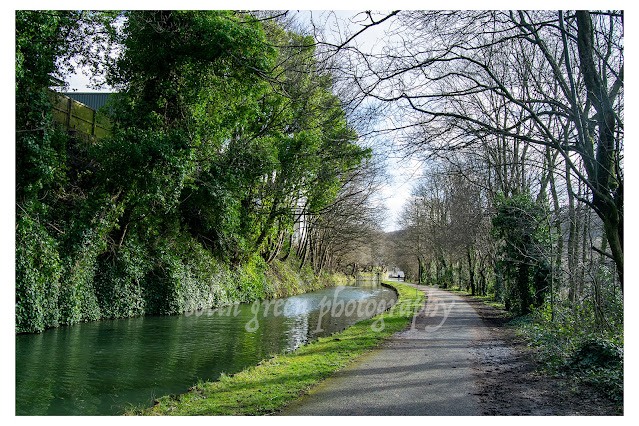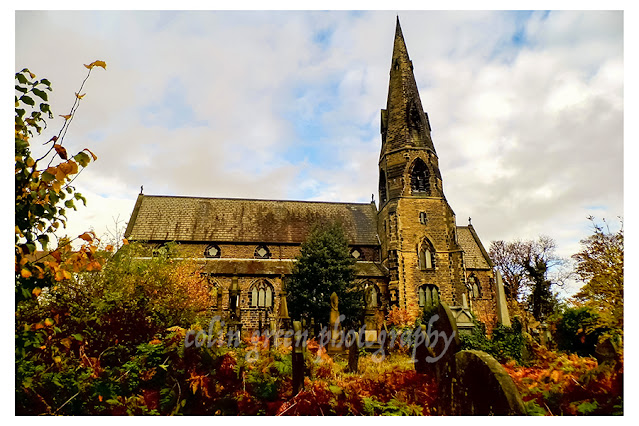Halifax Branch Canal artworks is a set of 6 pictures of the Calder & Hebble Navigation spur towards Halifax from Salterhebble Locks. They are digital creations of prints showing various points along the what remains of the canal that used to run up towards the Halifax.
Wednesday, 20 September 2023
Halifax Branch Canal Artworks
Thursday, 8 September 2022
The Calder and Hebble Navigation February 2020
The Calder & Hebble Navigation is a canal that runs through West Yorkshire linking Sowerby Bridge with Wakefield. It is a broad canal opened in 1770 following a path created by the Rivers Hebble and Calder of which the canal navigates in sections along its route.
The section featured in these pictures is between Sowerby Bridge basin where the canal connects with the Rochdale Canal and Salterhebble Locks which are the first set on the canal, just after the canals junction with the Halifax Branch Canal.
The pictures were taken on the 29th February 2020, this was just before the UK entered the period of lockdown and uncertainty that the covid pandemic was to bring. There are a total of 13 to view which can be seen below or on Clickasnap full size, resolution and un-watermarked.
Sunday, 21 August 2022
All Saints Church, Salterhebble
All Saints Church is an Anglican place of worship in the Salterhebble area of Halifax, West Yorkshire and has the Parish of All Saints named after it. The foundation stone was laid on the 26th August 1857 and the church was designed by James Mallinson and Thomas Healey who designed several churches in the nearby area. Samuel Rhodes was a major benefactor in the construction of the church providing over 400 cart loads of stone from his own quarry for the building. The church opened in 1858 and has been in continuous use since.
These pictures were taken using a Polaroid is2132 bridge camera on the 24th October 2014, they can be seen below or on Clickasnap where they are full size, resolution and un-watermarked.
Sunday, 5 June 2022
Artworks of Calderdale
Artworks of Calderdale if a YouTube slideshow of over 50 drawings, sketchers and art images based on photographs by me and some historical images of photo's and postcards by others. Many areas of Calderdale feature and much architecture and scenes are also shown within the video. The images are all set to music by Strauss and Liszt.
Images 1,2,5,6,8,12,15,18,19,23,26,28,31,32,34,36,37,38,40,41,43,45,46,47,48,49,51 and 53 are based on photographs by me and the full copyright belongs to me.
All the other images featured are based on postcards and photographs taken by others, the original copyright remains theres, the artwork copyright is mine. I am happy to credit them if required.
Please take a moment to subscribe to my YouTube channel
Friday, 13 April 2018
Unexpected Waterfalls and Canal Charms: Woodside Mill Lock's Hidden Display
Sometimes, the most captivating sights are found in the everyday, along well-trodden paths. On a recent stroll along the tranquil canal towpath connecting Elland to Salterhebble, I encountered a delightful, albeit temporary, spectacle at Woodside Mill Lock. This particular lock, a familiar landmark on my regular walks, usually presents its characteristic trickle of water cascading over the lower gate – a gentle reminder of the canal's ever-flowing nature.
However, this time, the scene was dramatically different. The lock, evidently recently used, was in the process of refilling. This resulted in the upper gate becoming a miniature waterfall, a torrent of water rushing over its lip and into the lock chamber. The sheer volume of water, combined with the rhythmic rush, transformed the familiar lock into a captivating display of hydraulic power.
It's a reminder of the intricate engineering that keeps our canals functioning, and how even routine processes can create moments of unexpected beauty. The contrast between the typically serene canal and the forceful flow of water was striking. I paused to capture this fleeting moment, grabbing my Samsung Tablet to record a short video.
The video, which you can view below, showcases the unexpected waterfall in all its glory. The sight and sound of the water, coupled with the peaceful backdrop of the canal, made for a truly memorable experience.
Woodside Mill Lock, like many along our canals, holds a rich history. Once a vital part of the region's industrial backbone, these locks facilitated the transport of goods and raw materials. Today, they serve as a reminder of our industrial heritage and offer a peaceful escape for walkers, cyclists, and nature enthusiasts.
This unexpected encounter with Woodside Mill Lock's 'waterfall' serves as a gentle reminder to appreciate the small moments of beauty that surround us. Whether it's the gentle ripple of the canal or the temporary cascade of water over a lock gate, there's always something new to discover along our waterways.
Saturday, 17 February 2018
Echoes in the Rock: Uncovering the History of Bank House Tunnel, Copley
Nestled into the verdant slopes of Salterhebble Hill, near Halifax, lies a silent sentinel of Victorian engineering: Bank House Tunnel, also known as Copley Tunnel. This short, curved railway passage, carved through solid rock, stands as a testament to the ambition and ingenuity that fuelled the expansion of Britain's railway network. While its precise construction date remains elusive, its proximity to the iconic Copley Viaduct, opened in 1852, strongly suggests a contemporaneous origin.
This tunnel, a vital link connecting Sowerby Bridge with Halifax, plays a crucial role in the region's railway infrastructure. A few hundred yards beyond its northern portal, the line converges with the original branch line stretching from Greetland to Halifax, marking a point of historical and operational significance.
On a crisp autumn day, October 25th, 2014, I ventured to capture the essence of this historical site with my trusty Polaroid iS2132 bridge camera. The resulting images, offer a glimpse into the tunnel's rugged beauty and the surrounding landscape.
A Journey Through Time and Stone
The tunnel's curved design, necessitated by the terrain, adds a unique character to its structure. Imagine the steam locomotives of yesteryear, their rhythmic chugging echoing against the rock walls as they navigated the bend. The very stone that forms the tunnel's walls bears witness to the countless journeys undertaken, the freight carried, and the passengers transported.
The relationship with the Copley Viaduct is crucial to understanding the tunnel's history. The viaduct itself is a marvel of Victorian engineering, spanning the Calder Valley with its elegant arches. It’s highly probable that the tunnel, being a crucial part of the same line, was constructed during the same period to facilitate a continuous and efficient railway connection.
The convergence of lines near the tunnel's northern exit highlights the strategic importance of this location. The Greetland branch line, another historical artery, further emphasizes the region's role as a vital hub for industrial and commercial activity.
A Visual Exploration
The photographs captured on that October day reveal the tunnel's raw, unadorned beauty. The interplay of light and shadow, the texture of the rock face, and the subtle curve of the tunnel’s interior all contribute to a sense of timelessness. The surrounding landscape, with its rolling hills and verdant foliage, provides a serene backdrop to this industrial relic.
Important Note:
It is crucial to emphasize that all photographs were taken from publicly accessible areas. At no point did I enter any restricted railway property. Railway lines are inherently dangerous environments, and unauthorized access is strictly prohibited. I strongly discourage anyone from attempting to enter such areas.
Unanswered Questions and Lingering Mysteries
Despite the information gathered, some questions remain. The exact date of the tunnel's construction, the specific methods used in its creation, and the stories of the workers who built it are just a few of the lingering mysteries. Further research, perhaps through historical archives and local records, could shed more light on these aspects.
The Enduring Legacy
Bank House Tunnel, or Copley Tunnel, stands as a silent testament to the ingenuity and perseverance of the Victorian railway builders. Its rugged beauty and historical significance make it a fascinating subject for exploration. As the trains continue to traverse its curved passage, the echoes of the past resonate within its stone walls, reminding us of the enduring legacy of Britain's railway heritage.
This blog post is intended to offer a deeper appreciation for the historical and architectural significance of Bank House Tunnel. It serves as a reminder of the importance of preserving our industrial heritage and respecting the boundaries of safety.
Clicking any image below should open a link in another window to my Colin Green Photography store on Zazzle.
 |
| The northern portal, Salterhebble side of the tunnel. This was quite difficult to reach having to climb down an embankment and through dense overgrowth to get somewhere near to take the picture. |
 |
| The southern portal Copley side of the tunnel. |
 |
| Looking down towards the tunnels northern portal. The embankment I climbed down was the opposite side beyond the fence. I would not encourage anyone to do this. |
 |
| Halifax bound train entering the tunnel. |
 |
| Sowerby Bridge bound train exciting the tunnel. |
Sunday, 4 June 2017
The Halifax Branch of the Calder & Hebble Canal: A Lost Waterway
Just a whisper of its former self, the Halifax Branch of the Calder & Hebble Canal now stretches a mere half-mile from Salterhebble Junction and its locks to the Watermill Bar at Salterhebble Wharf. This truncated remnant is all that remains of a once vital artery that pulsed with industrial life.
Opened in 1828, the canal climbed a formidable 14 locks to its original terminus at Bailey Hall, a location now occupied by the bustling train station and the interactive Eureka! museum. Imagine the scene: barges laden with goods, lock keepers busy at their work, and the constant hum of industry. But the rise of the iron horse and the advent of tarmac roads spelled the canal's decline. By 1942, the upper section, from Salterhebble Wharf to Bailey Hall, was abandoned, its waters drained and its towpaths reclaimed. Today, the Hebble Trail, a popular cycle and pedestrian route, winds its way along the canal's former path, offering little hint of the waterway that once flowed there.
While whispers of reopening this lost stretch occasionally surface, fueled by hopes of boosting Halifax's tourism, such dreams face a stark reality. A more visionary local council might seize the opportunity to resurrect this historic waterway, but with tight budgets and a perceived lack of ambition, the chances of seeing barges once again navigating through the heart of Halifax seem, sadly, remote.
 |
| Wakefield Road Bridge. The canal brakes off to the left just beyond the bridge through Salterhebble Locks in the direction of Brighouse. |
 |
| The abutment to the right used to support a bridge that crossed the canal here. The bridge has long since been removed. |
 |
| Salterhebble Moorings can be seen in the distance. Tihs is where the canal now ends. |
 |
| To the right of the Watermill Bar is Salterhebble Tunnel. The canal continued through there and immediately entered lock 1 of the 14 on exiting the tunnel. The stone lock walls can still be seen. |
 |
| The modern day end of the Halifax Branch Canal. The Watermill Bar and Restaurant occupies what was the site of Salterhebble Mills. There is also a Premier Inn hotel on the site, |
Through a Glass, Darkly: Hebden Bridge Railway Station in Negative
There's something hauntingly beautiful about old photographs, especially when they're presented in a way that flips our perception....

-
Have you ever wondered about the imposing wall that lines a stretch of the Rochdale Canal in Todmorden? It's not just a simple retaining...
-
Passing through Brearley, a small village between Luddendenfoot and Mytholmroyd, West Yorkshire on the Route 66 of the national cycle netw...









































